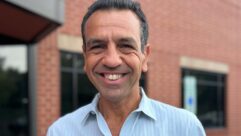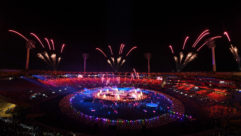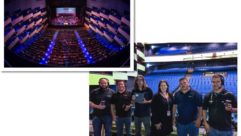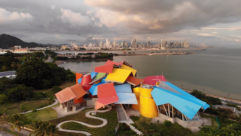
Fiber Of The Caribbean
WorldLink makes long runs easy, using fiber to transport signals throughout the beautiful Paradisus Palma Real Hotel.
CHALLENGE: Transport audio and control signals over more than 2.5 miles of fiber-optic cable throughout a sprawling resort complex.In this case of the Paradisus Palma Real, the hotel’s fiber backbone for Ethernet and telephone had two extra fibers available, “so we used one for audio and one for control” says Hermida. “In the end, we only had to run a few additional lines of fiber ourselves for racks that were not in the path of the existing fiber runs. ”THE ULTIMATE IN CONFERENCE ROOMS
The Paradisus Real Hotel of Bavarro Punta Cana boasts more than it’s luxury. An integrated solution gives the abitlity to control audio/visual over the resort’s vast expanse.
SOLUTION: Use existing fiber runs and powerful DSP functionality for quick response control and distributed audio.
THE DOMINICAN REPUBLIC can boast two things: thousands of tourists flock there every year, and it is home to some impressive hotels that host a variety of entertainment, so guests never have to leave the resort properties.
Among these resorts, the Paradisus Palma Real Hotel in Bavaro Punta Cana, is one of the most luxurious in the Dominican Republic and one of the leading destinations in the Caribbean.
Sol Melia, parent company of the Paradisus Palma Real, called on WorldLink, one of the Caribbean’s best known AV integrators, to provide a fully integrated solution for the hotel. In doing so, WorldLink used some ingenuity to design a system that could reside on a single network, offer intuitive control and deliver an audio/visual experience unlike any other.
The sprawling Paradisus Palma Real, which opened in 2005, incorporates 15 conference rooms, three bars, six restaurants, more than 35,000 square feet of swimming pools and recreational areas, a spa and gym, and 600 luxury suites, including 192 royal suites (600 square feet each). The administration facilities include the lobby, front desk, royal service area, vacation club and all other social areas.
Distributing audio throughout the property was particularly difficult. The audio alone would require thousands of feet of cable, and the additional video and presentation capabilities in the ballrooms and boardrooms easily would double that number.
Felix Hermida of WorldLink recounts his first impressions of the project’s size and scope. “When we considered the complexity of adding audio and video capabilities to this magnificent hotel, we quickly realized we would need to rethink our traditional approach,” says Hermida. “It became apparent that our biggest challenge would be the sheer distance between racks situated in each zone. We had done other installations using fiber-optic cable to deliver signals over a very long distance, and we thought this might be an appropriate solution.
Each receiving rack is outfitted with a Transition Networks receiver to take incoming fiber-optic signals, convert them back to CobraNet, feed them into an AudiaFLEX and transmit them to the amplifiers.
For the audio requirements, WorldLink incorporated an extensive AV system that includes the ability to play back different music throughout the resort: in the lobbies, bars, waiting areas, pools, etc. This required 27, 40GB Marantz DN-V755 network audio/visual players to store music selections and make them available for on-demand play. The hard-disk recorders are housed in a Middle Atlantic Products rack in the manager’s office, where all of the hotel’s other audio input components, including two Marantz Professional PMD970 5-disc DVD players, are kept.
These input sources are fed to two Biamp AudiaFLEX CM units that are responsible for receiving the audio signal, converting it to CobraNet protocol and distributing it. In total, the system comprises approximately two and a half miles of Belden single mode fiber-optic cable.
Because of the distance between the central rack and the four other racks designated for local distribution, the CobraNet signal is sent via Cat-5 to a Transition Networks converter, converted to a fiber-optic signal and routed to the strategically placed “receiving” enclosures around the hotel. Each receiving rack is outfitted with a Transition Networks CEFTF1014-205 to take the incoming fiber-optic signals, convert them back to CobraNet, feed them into an AudiaFLEX and transmit them to QSC and Biamp amplifiers for playback. Audio is then sent to 581 EAW ceiling speakers and loudspeakers—a combination of CIS300, CIS400, SRM450, VR Series and SMS Series—and 337 Niles Performance Rock Loudspeakers in various colors that hide the speakers’ presence outdoors.
“Once we decided that using fiber to send our signals was the best way to proceed, we needed to figure out how to send input from 27 audio sources using only a single fiber cable, and still provide an adequate level of control in each area using the same cable,” says Hermida. “We had never dealt with that many sources before, and we were definitely concerned with the amount of bandwidth we would need to support all of the information being sent.”
FOR MORE INFORMATION
Barco
www.barco.com
Belden
www.belden.com
Biamp
www.biamp.com
Boxlight
www.boxlight.com
Crestron
www.crestron.com
Denon
www.denon.com
EAW
www.eaw.com
Marantz
www.marantz.com
Middle Atlantic Products
www.middleatlantic.com
Niles
www.nilesaudio.com
Transition Networks
www.transition.com
WorldLink
www.worldlinkrd.com
In addition to the CobraNet signals, the fiber-optic cables also carry control signals from four primary computers—three IBM PCs and one Dell laptop—running Biamp’s daVinci control software, among other programs. These primary control computers are located in reception, the manager’s office, and the restaurant manager’s office and on a laptop computer used by a full-time hotel DJ. On each of these computers, employees have password-protected access to an easy to use GUI for monitoring volume levels and music selections in ever zone.
Additionally, the hotel manager can listen to the music played in each zone through a set of monitor speakers in the office. This same system is controlled by a Crestron AV2 processor that automatically recalls specialized presets in the AudiaFLEX, based on time of day. For instance, volume levels can be adjusted automatically as the dinner crowd begins to arrive, or muted once the restaurant closes for the night.
“With the daVinci software, we were able to create custom control screens for each zone. To do this, we took a photo of each area and created graphic audio controls—sliders, on/off switches that sit on top of the jpeg. Therefore, if the restaurant manager wants to change the audio input or volume levels in one of the restaurants, he immediately sees a photo of that particular zone along with the current settings. It eliminates any question as to what zone has been selected, and allows for quicker operate volume and input controls.”
Local control over the volume settings also is possible. For this, WorldLink installed Biamp Volume Select 8 panels in each of 37 areas, so employees easily could manage volume at their discretion. Because the daVinci program and wall-panel controls reside on the same network, system changes made at either the PC stations or the wall-mounted volume controls are reflected at every location and can be changed locally or from one of the four control stations.
Upon completion of the project, Hermida says the estimated cost for the Cat5 converters was between $7,000 and $10,000. “In comparison to the estimated of $70,000 for materials, labor and wiring, using fiber was a huge cost advantage,” says Hermida. “But what was more important for this project was the amount of time we saved by taking advantage of what we already had, and using a bit of creativity in our design.”
In addition to its audio capabilities for entertainment, the Paradisus Palma Real Hotel also features state-of-the-art conference rooms. Set up on a separate network, the rooms make full use of a Crestron and AudiaFLEX control system for individual control options in every section.
From an audio standpoint, the 27,000-square-foot conference area can be zoned into 15 separate rooms. The size of the room, with 24.6-foot high ceilings, posed an acoustic problem. WorldLink decided on Biamp’s AudiaFLEX for the conference room as well, making use of its programming capabilities and automatic EQ functions to eliminate reverberation within the space, regardless of its setup.
daVinci software allows jpeg photo files to be imported, so that the user can easily visualize which zone is being adjusted.
When the rooms are segmented, hotel employees can choose from a number of different presets within the AudiaFLEX to distribute audio sources accordingly to each zone. When the room is used in its single, large state, the AudiaFLEX can be returned to its original settings to EQ and mix accordingly. Additionally, employees or guests have local control over the conference room sound via Biamp VS8 wall panels that control volume settings.
The high ceilings were also a big challenge for WorldLink when it came time to install video. Mounting the Barco IQ-R350 and Boxlight CP3241 projectors from the ceiling was only part of the problem. Because of the ceiling height and overall distance from the localized AV rack, cable runs once again became an issue. In this case, WorldLink transmitted the three necessary video signals (VGA, Super Video, Composite) via Crestron QuickMedia Protocol over a single Cat5 cable for each projector.
Karl Pawlewicz is a writer and public relations consultant for the AV industry. He can be reached at [email protected].










